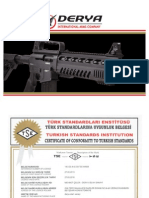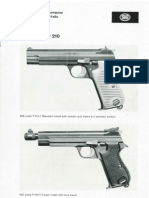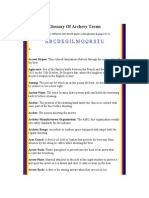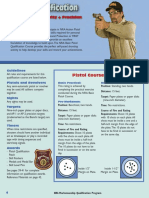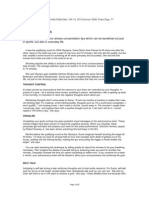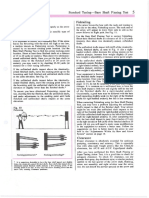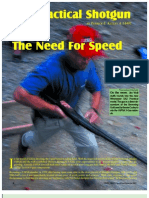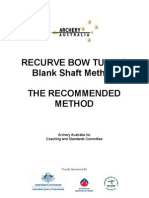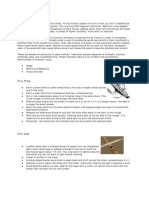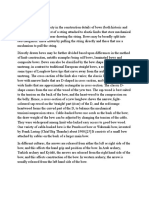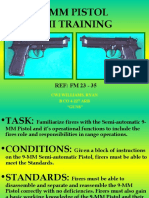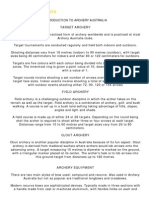Basic Handbook
Basic Handbook
Uploaded by
scottymacqueenCopyright:
Available Formats
Basic Handbook
Basic Handbook
Uploaded by
scottymacqueenOriginal Description:
Copyright
Available Formats
Share this document
Did you find this document useful?
Is this content inappropriate?
Copyright:
Available Formats
Basic Handbook
Basic Handbook
Uploaded by
scottymacqueenCopyright:
Available Formats
Archery
Archery
Handbook
Handbook
Fair Play Philosophy
help your athletes develop a positive self image
promote respect for the rules, officials and their
decisions
promote respect for your opponents - respect his/
her space on the line or in the shooting lane; keep
quiet so the other archer can focus on the job of
shooting
load your bow in a vertical position so you do not
interfere with other archers on the line; also, when
at full draw, be careful not to interfere with the other
archer
when leaving the line after shooting the end, do not
leave when the adjoining archer is at full draw
encourage a constructive attitude toward competi-
tion
develop a sense of dignity under all circumstances
provide an equal opportunity for all to learn skills
encourage participants to continue participation in
sport
don't touch another archer's equipment without
permission
Introduction
The novice who reads this booklet will be guided in
acquiring equipment suited to his purpose. By the study
of the shooting techniques contained herein, he can,
through strict self-discipline, acquire good shooting
form. Whether on the target range, the field course or
in the hunting field, the ability to shoot well enhances
the sport of archery and increases the recreational
possibilities for every member of the family.
signal to collect arrows with three blasts. A se-
ries of short blasts is to signal danger and all
shooting must cease.
3. Dont draw a bow without an arrow. Only draw
a bow when on the shooting line with the arrow
pointed to the target. Releasing the string with-
out an arrow will likely cause damage to the bow
limb.
4. Indiscriminate shooting, such as at objects other
than the target or high in the air is dangerous
and thus not allowed.
5. Never aim a bow at anyone.
6. Dont handle other archers equipment without
permission.
7. Spectators are to be kept well back of the shoot-
ing line.
8. Keep chatter to a minimum while other archers
are on the line.
9. Keep your equipment in good repair.
10. Be a good sportsman. Courtesy shown to your
fellow archer will earn the same in return.
23
3 22
5. Arrows not matched to bow
B. Arrow slapping bow
1. Bow arm wrist too far inside the bow
2. Arrows not matched to bow
3. Tension in the bow hand
4. Brace height too low
C. Excessive bow noise
1. Brace height incorrect
2. Arrows not matched to bow
3. Compound not properly adjusted causing parts
to touch on release
4. Loose parts (including arrows)
D. Arrow falling away from bow on draw
1. Pinching arrow between fingers
2. Not drawing straight back
3. Hook of fingers not deep enough
4. Failure to let the string roll towards end of fin-
gers on draw
5. Back of string hand not straight
6. Tension in the string hand and knuckles
Safety - The bow was originally designed as a very
efficient instrument for hunting and war. Al-
though the target arrow is not as lethal, archery
still has the capability of being a very danger-
ous sport and safety should never be taken for
granted. Safety is of prime importance both for
the hunter and the target archery.
1. Bows should only be drawn on the shooting line
when it is safe to shoot.
2. On the target range, all shooting is under the
control of a target captain, who will signal the
start of the shooting with one blast and a
ARCHERY
BASIC HANDBOOK
History
The history of archery dates back to earliest times when
the crude bow and flint arrowhead provided our an-
cestors with their food. During the Middle Ages, the
bow was supreme on the battle fields of Europe. In
our present society, archery is the sport and relaxation
for thousands throughout the world.
The urge to shoot bows and arrows is latent in all of
us. Every nation used the bow and arrow and, as time
progressed, developed their own individual type of
tackle. Early Saxon and Norman Archery perfected
the famous, English long bow and the cloth yard ar-
row. Germany, France, Spain and Italy seemed tem-
peramentally unsuited to long bow archery and devel-
oped the crossbow.
With their composite bows, the Orientals reached per-
fection in the bowyers art. Shredded sinew in special-
ized glue formed the backs; a very thin strip of wood
separated the back from the horn belly.
The Turks, who produced the most beautiful weapons,
left the polished horn belly exposed, while the Persians
and the men of India covered the whole bow with raw-
hide, birch bark or thin layers of shark skin. The bows
of the American Indian were all shapes and sizes. They
were usually quite crude but nevertheless effective. The
Indian was a hunter rather than a long distance archer.
His knowledge of woodcraft and his ability to stalk game
made up for what his weapon lacked in range.
21 4
The Fundamentals of Archery
Keeping Fit - Archery is not recognized as being a physi-
cal sport but with a little analyzing, the exercise value
of energy expended come to light. The shooting of a
single FITA round requires 150 shots. Lets say the
bow used is forty pounds. It will take 150 X 40 - 2000
pounds or 1 ton plus a minimum walk of 3840 meters
just to the target and back.
Equipment - Todays bows are usually either recurve
or compound design. The most used manufacturing
process is the composite which consists of a layer of
fiberglass on each side of wooden strips. The bow is
strengthened near the grip to allow part of the handle
to be cut so that the arrow can be shot from inside or
on the center line. The long bow and pre-takedown
era bows had to be shot outside center. The long bow
is still used today by the traditionalists of the sport, but
mainly in a simulated hunting environment.
Various refinements and aids are added as desired;
these include sights, stabilizers, release aids, etc., how-
ever none of these accessories are required to learn
the basics of archery. Most recurve bows of today are
of the take down type, which aids in convenience of
traveling and limb replacement. Most modern com-
pounds also take down quite easily. Many different
makes are available at your local archery shop as is
much needed advice on any questions you may have.
Compound VS Recurve - While the compound and
recurve are very different looking bows, the fundamen-
tals of shooting them or any other bow, are exactly the
same. The basic steps of archery are
Nocks must be put on the arrow absolutely straight and
be the proper size for your string. Straightening ar-
rows is a job that is often performed by the experts but
the skill can be mastered with patience and practice.
Arrow Rests - In recent years the arrow rest has proven
to be a favorite with the archery inventor. There are
literally thousands on the market. For the beginner's
bow, it is important to check that the rest is sturdy
enough to hold the arrow from the same point every
time.
Bow Sights - The addition of a sight should be checked
for correct alignment. The vertical sight bar should be
parallel to the string. Assistance should be sought out
from your local pro shop or club instructor, if adjust-
ments are difficult.
Correction of Basic Faults - After the initial form has
been learned, it is not always possible for an experi-
enced coach to be present when problems occur. It is
important to be able to do a least basic self diagnosis.
The ten basic steps form the very basics of the sport.
Seldom are faults diagnosed one at a time, but usually
manifest themselves in groups. One should work on
the major fault first.
The following list will help determine where to look when
certain problems are noted:
A. Erratic arrow flight in the air
1. Obstruction to the string, clothing, etc.
2. Poor release, which could also cause the string
to slap the arm guard
3. Arrow nock too tight
4. Bow arm wrist too far inside the bow
5 20
Exact sizes are determined by charts provided by the
manufacturer. It is best to seek out professional ad-
vice in arrow purchase. Just to be sure, take your club
coach with you when you purchase arrows. Spine is
the measurement of the amount of bend caused by a
two pound weight suspended from the arrows center,
calibrated in thousandth of an inch. Generally, there
are four types of arrow material: wood, fiberglass, alu-
minum and carbon graphite.
Wooden arrows are not as popular today because it is
difficult to find a matching set and they are not as du-
rable as the new manufactured materials. They are
still widely used by the traditional or long bow archer.
Fiberglass is good for a beginner class because of its
durability.
Aluminum makes an excellent arrow that is both con-
sistent and durable. These arrows are also easy to
straighten when bent. They are sized by a 4 digit code
such as 1816. The first two digits denote the shaft
diameter in 64th of an inch. The second two digits
denotes the shaft width in thousands of an inch. There-
fore, an 1816 is 18/64th of an inch in diameter and 16/
1000th of an inch in wall thickness.
A popular choice amongst the top tournament archer
is the carbon graphite arrows. These arrows allow for
greater speed due to their stiffness, small diameter and
light mass weight.
Arrow Maintenance - Arrows should be kept clean and
checked for straitness regularly. Fletches must be at-
tached uniformly and must not come in contact with
the bow when the arrow is shot.
the same on the world tournament line as they are in
the bush in a hunting scenario. Good basics, learned
early in ones archery career, will provide an excellent
foundation for years of future enjoyment.
Stringing the Recurve Bow - The
only method of stringing a bow that
is entirely safe is using the stringer.
For the purposes of this manual, the
most recommended, safest, easiest
and best for the equipment is the
stringer method. The step through
method, if not performed absolutely
correctly will cause permanent limb
twist. The push-pull method is very
dangerous for both personal and
equipment safety and is not recom-
mended.
Bow Stringer Method - Place the bowstring on the
bow with the larger loop over the upper limb; then place
the smaller loop over the lower limb tip, ensuring the
loop fills both grooves (a small elastic band may be
used to hold this loop in place). Place the larger pouch
over the lower limb tip and string loop. Next place the
smaller pouch over the upper limb tip; now stand on
the cord of the stringer with feet about 12 apart, grasp
the bow at the handle with one hand and pull. As the
limbs bend, push the upper string loop into place on
the upper limb tip. Once it is in place, slowly lower the
bow, watching to ensure the string is properly seated
in both limb tips. After removing the stringer check the
limb tips again.
The stringers cord length may have to be adjusted to
accommodate shorter archers, or open the distance
between the feet on the cord.
19 6
Stringing the Compound Bow - Bow stringers are
also available for the compound bow, but such adjust-
ments should only be carried out by experienced per-
sonnel. Serious equipment damage or personal injury
can result by improper adjusting. Consult the bows
owners manual or take it to your local pro shop.
Basic Instruction - At the outset, it should be men-
tioned that during the first lessons, bow weight is most
important.
Basic form must be learned at the earliest to give a
firm form foundation. Therefore, the archer should be
able to concentrate on form and not be struggling with
bow weight. A very light bow is needed during the first
lessons; as a rule of thumb, 20 pounds is recom-
mended.
Archery is not a test of strength, although physical fit-
ness plays a very important part when a competitor
reaches the level of National and International compe-
titions. Archery is a test of skill, and requires instruc-
tion and practice to attain any level of proficiency. There
is no magic formula that will produce high scores, no
short cut that will eliminate the need for personal effort.
In archery you compete against yourself and high
scores are in direct relationship to the intelligent effort
and practice put forth by the individual. Generally, ar-
chery is not much of a spectator sport. Satisfaction
comes from the skill developed by the individual hitting
the mark. The beginning archer should be encouraged
to practice as much as possible at close distances, not
to move back more than 15 or 20 meters. During the
first few lessons, basic form is to be learned. Testing
accuracy too early can lead to a discouraged pupil.
Arrows - By far the most important piece of the archers
equipment is the arrows. Arrows must be matched to
the bow. Amazing scores can be shot with a third rate
bow with matched arrows. Initially, it is a good idea to
have arrows that are slightly longer than necessary.
Safety is more important with the beginner archer than
fine tuning of arrows.
Arrow Length - For recurve style archers, the length
of the arrows should be approximately the distance be-
tween the chin and the tips of the fingers. Instinctive
archers may need to add about one inch due to the
side anchor. Beginning archers may also be advised
to add an additional 1/2" to allow for stretching out that
may occur in future lessons. It is far better to cut long
twice than short once.
The most recommended method of measuring draw
length for a beginner is to use a piece of doweling cali-
brated in inches with a nock attached. Have the ar-
cher draw a very light bow several times. Then ask
him or her to come to full draw with eyes closed. Ob-
serve the length, repeating the process several times.
The average is the draw length. This process is used
for beginners and to check the exact draw of very ex-
perienced archers. The actual point is not included in
the length measurement.
Hunting arrows must be from 1/2 to 3/4" longer for
broadhead clearance.
Arrow Selection - Arrows are sold according to bow
weight and arrow length. The heavier the bow, the stiffer
the arrow. For the same size arrow, the shorter is stiffer
and the longer is more limber.
7 18
pinch that happens with a similar recurve bow.
Bow Storage - Recurve bows should be unstrung af-
ter each session. This is not necessary with com-
pounds. All bows should be stored in padded cases
between sessions. Bows can also be stored horizon-
tally on wooden pegs on the wall.
Strings - Check the limb tips and nocks at both ends
for sharp corners or uneven surfaces, which might
cause undue string wear. Worn strings should be re-
placed before breakage occurs; servings should be
kept in good condition. Occasionally the string can be
lightly waxed and rubbed with a piece of leather. Twists
in a string should be few and should be kept in the
same direction as used in the single strands which make
up the unit. Strings usually break in the loops or at the
nocking point. If you break a string, check that part of
the bow for rough or sharp edges. A break at the
nocking point usually means a to tight or too sharp nock
set.
String Material - Dacron strings have a very long life
because they stretch slightly on release. This elastic
quality allows them to be used for many thousands of
shots. This quality is not inherent in Kevlar or Fast
Flight strings. These strings do not stretch at all on
release. Kevlar strings usually break in under two thou-
sand shots. Fast Flight strings have a much longer
life, possibly surpassing the life expectancy of Dacron.
Because of this lack of stretch, more speed is attained,
but there is a sacrifice of limb life in some bows. Fast
Flight is also very hard on some compound limbs and
cables. Always check your manufacturers warranty
before using Fast Flight. If in doubt, consult a bowyer
or a coach.
However, there are certain basic steps which, when
followed, make it easier for the archer to do the same
thing every time and to develop rhythm. These steps
have not changed a great deal since the days when
Roger Ascham wrote Toxophilus or the Art of
Shootinge the Bowe in 1545 during the reign of Henry
VIII.
Eye Dominance - It is well worth the extra time to en-
sure proper eye/hand dominance before starting. It is
most difficult to change later. There are very few cases
where someone cannot shoot with their dominant eye.
Where these special circumstances occur, it is best to
try to start with the dominant eye.
Straighten your arms, cross your thumbs with palms
open and away from you. Make a small hole between
your thumbs and index fingers. Have someone stand
about 10 to 15 meters away and look at his forehead
through the hole. The eye he or she sees is the domi-
nant eye.
Another method is to look at an object across the room
and while concentrating on it, pull your hands back to-
ward your eyes; the hole will end up over your domi-
nant eye.
Basic Steps - These steps in shooting are the most
important part of archery, and they must be concen-
trated on at all times. The beginning archer must
become familiar with these steps, for all archers must
come back to review them often.
17 8
When referring to the various steps in shooting form,
we will deal with the right handed shooter. Items are
reversed for the left hander.
1. Stance 6. Anchor
2. Nocking the arrow 7. Hold and Aim
3. Bow hand 8. Release
4. String hand 9. Follow-through
5. Draw 10. Relax
Stance - Take a position on the shooting line with your
left side to the target. The feet should be spread com-
fortably apart, weight distributed evenly on both feet.
Toes are touching an imaginary line to the target. Knees
are relaxed, not locked backwards. The shoulders
should line up with an imaginary line drawn from the
center of the target to the archer. This is the regular
stance. The opposite is true for left handers.
Another common stance is the oblique method. This
stance allows for better chest clearance. The archer
stands with the toe of the left foot about ten inches to
the left of the line to the target. The body is pivoted at
the waist until the shoulders are lined up at right angles
with the target.
The important point concerning stance is that the feet
should be in the same position for each arrow. Look
along the left shoulder at the target. Always stand erect,
with the body centered over the feet.
Nocking the Arrow - Hold the bow vertically; draw an
arrow from the quiver and place it on the arrow rest,
holding it near the fletches with the thumb and forefin-
ger of your right hand.
adjustable and the only accurate way to ascertain peak
and hold weight is to actually weigh them on a bow
scale. Compound bows should never be adjusted
above the weight range recommended by the manu-
facturer, doing so will most certainly void any warranty.
Bow Weight (recurve bow) - Recurve bows are also
marked on the lower limb with the bow weight. This
weight is measured at an industry standard. This is
usually also marked and will say either 26 1/4 (or AMO)
or 28 inches. 26 1/4" is the standard measurement to
the bow rest and 28" is the standard measurement to
the face of the bow. In most cases, these two mea-
surements may be treated as the same. By using cor-
rect draw length we can accurately estimate actual bow
weight. Most bows increase at a rate of approximately
2 pounds per inch near 28". So if we take the marked
weight and add or subtract 2# for every inch over or
under 28" we will have our actual recurve bow weight.
Some of the more modern competition recurve bows
are adjustable for weight over a range of 4 to 5 pounds.
While the above methods allow for a fairly accurate
estimation, the only way to ascertain exact weight is to
weigh the bow at the archers draw length.
Bow Length - A bow should be selected according to
the physique of the archer. A longer bow is more com-
fortable with target archery, while a short bow is more
practical when bowhunting. The most common recurve
lengths are 64, 66, 68 and 70 inches. A 70" bow is
usually used by a man about 6 feet tall, while the shorter
or longer bows allow archers of different stature to take
advantage of the full use of the recurve limb. In com-
pound bows, the eccentric wheel allows for a much
shorter bow to be used without the degree of finger
9 16
After a tournament, returning from hunting or just a prac-
tice session, check the bow over from top to bottom.
Cracks or dents should be protected at all times with a
good quality paste wax or car wax.
When you first get a bow, a few minutes spent making
some critical measurements will save much time dur-
ing future fault finding. Write these measurements down
and store them with the bow for instant referral. The
string height or brace height (distance from the arrow
rest to the string) is very critical in some bows. This
should be checked each time the bow is strung and
before each shooting session. Variations of string
height at the upper and lower limbs, where the limb
core fades into the limb, should also be checked; in
most bows this is 1/8 to 3/16 inch greater at the top
than the bottom. In many compounds, this measure-
ment is near equal. The strings nocking point mea-
surement should also be checked frequently. This mea-
surement is usually about 1/4 inch above 90 degrees
from the rest. Refer to an owners manual or a coach-
ing manual for diagrams on equipment.
All modern bows, compounds and recurves, are sub-
ject to limb twist. On a recurve a twist is noticeable if
the string does not cut the center of both limbs and the
handle section when strung. p A twisted limb on a com-
pound shows up when the eccentric wheels tip to one
side as the bow is drawn. Limb twist in a compound
bow is a by-product of the transfer of the bows weight
from one side of the eccentric to the other during the
draw.
Bow Weight (compound bow) - Most compound bows
are marked on the lower limb with the draw weight and
the peak weight range. Compound bows are
Lay the arrow on the arrow rest and revolve the arrow
until the cock feather is perpendicular to the string and
bow. Move the arrow back until the bow string is se-
cured to the arrows nock saddle. The arrow is no longer
held by the fingers, but stays due to the nocks snug fit
on the string.
It is important to learn not to hold the
arrow on the rest with the index fin-
ger of the bow hand; this practice is
dangerous and with the proper size
of nock, it should not be necessary
to keep the arrow in place.
Bow Hand and Bow Arm - The hand which holds the
bow is called the bow hand. When an arrow is released
the bow should have complete freedom of movement.
An archer should not grip the bow but rather the bow
should be held against the base of the thumb by the
tension of the string. Most archers use a bow sling to
prevent the bow from falling out of the hand upon re-
lease.
The bow arm is simply extended and held out without
locking the elbow; it should not be stretched out and
locked. For better string clearance the elbow can be
rotated down and back. It takes some practice, but it
is a skill worth learning early.
Drawing Hand - The string
is drawn with the first three
fingers of the string or
drawing hand; one finger
is above the arrow and two
below. The thumb is re-
laxed in the palm of the
hand.
15 10
The string cuts across the fingers of the drawing hand
at about the first joint. While all three fingers should
work almost the same in drawing the string, the middle
finger will do slightly more work than the other two. Care
should be taken to see that the back of the hand, the
wrist and the third section of the fingers are in a straight
line. The analogy of carrying a bucket of water is often
used here. Bow arm is extended at shoulder level;
elbow joint is turned downward away from path of bow
string; shoulders are level. Pressure of the bow is
centered in the 'Y' formed by thumb and index finger of
bow hand.
Drawing the Bow (Barebow style) - The object is to
get the bow hand stretched out toward the target and
the string hand anchored at the side of the jaw or cheek.
This high anchor enables the archer to position his
aiming eye directly over the arrow so that the line of
sight and the line of flight are similar.
Extend the bow hand toward the target; at the same
time swing the bow almost to a vertical position. The
upper limb may be tilted slightly to the right to assist in
bringing eye immediately over the arrow. Leave the
bow arm slightly bent to permit the elbow to turn down
and back. This leaves a clearance for the bow string,
which might otherwise strike the inner side of the arm.
Now, with the drawing hand, pull steadily back using
the back muscles. Keep the el-
bow of the drawing hand high and
parallel with the arrow until the
forefinger of the drawing hand
touches the right corner of the
mouth. This is the position of an-
chor for the barebow archer.
some idea of what purpose they intend to use the equip-
ment for. Bow hunting, target shooting, field shooting,
recurve and compound are a number of examples of
shooting styles. The novice should consult with an
expert coach before purchasing equipment. This extra
information cannot do anything but good. For the
purposes of this manual, we will concern ourselves with
equipment for the new archer who has just begun the
sport.
Some of the muscles used to draw a bow are ones
which are seldom used for other sports and are often
under developed. Care must be taken to ensure the
first bow is light enough so that the archer can concen-
trate on basic form rather than struggling to draw the
bow. Therefore the bow used to teach a beginner must
be light enough that the beginner can draw it the proper
length without undue effort.
After the archer learns the proper form and has devel-
oped the muscles needed in the sport, he can then
graduate to a bow that is the proper weight for the job
or application required.
Most clubs have beginner equipment which can be used
for the first lessons, but the first purchase should be a
bow of lighter weight in the order of 25 pounds at 28
inches for juniors and women and about 30 pounds for
men.
Bows - A modern bow is an intricate piece of machin-
ery and needs maintenance and care to keep it in top
form.
Bows should be checked often for twists, flaws or dents,
and if anything is noticed, steps should be taken to rec-
tify damage immediately.
Drawing the Bow (using a sight)
When shooting with a sight, special effort must be
made to keep the bow vertical at full draw and not
canted or held on an angle. The drawing hand comes
back under the jaw bone until the bow string rests snugly
against the center of the nose and chin. Muscles of
the arm, shoulder and back should be used in sequence
during the draw. Right elbow moves in a line parallel
to the ground. The string moves in a line close to the
bow arm during draw.
The Anchor - The anchor is
the archers key to consis-
tency because the arrows
trajectory is dependent on the
amount of force applied to it
and the amount of draw gov-
erns the weight applied.
Also, the eye becomes the rear sight and must be a
consistent distance above the arrow. Both these fac-
tors understate the extreme importance of a good solid
anchor. With both barebow and sighted (recurve), it is
necessary to be sure to have the side of the hand
pressed tightly against the side of the face or under the
jaw bone.
Hold and Aim (barebow) -
This is sometimes referred to
as the hunting aim and is fa-
vored by many instinctive style
bowhunters.
Basically, one lines up the ar-
row with the target and lets go.
No short course can be given
here as it takes much practice
and experience.
11 14
Each arrow must be shot as a complete sequence of
events. Nothing from the previous shot should be car-
ried over to the next shot. Therefore, after each shot,
relax completely and take several deep breaths before
commencing the next sequence.
Pulling out the Arrows - Arrows improperly drawn from
the target may cause damage to the arrow or cause
personal injury.
Always ensure all arrows are scored before touching
them or any part of the buttress, while arrows that were
touched can still be scored, it is not possible to score
arrows already drawn.
When drawing arrows
from the buttress, first
ensure no one is di-
rectly behind you in
case the arrow is with-
drawn too quickly and
the arrow jabs back.
Place one palm against
the target so that the
arrow to be drawn is between the thumb and index fin-
ger. Grasp the arrow as close to the target with the
other hand, pull straight back until the arrow is moved.
Arrows should be removed one at a time, and each
arrow should be placed in the quiver after it is drawn.
Selection of Equipment - Many feel archerys worst
enemy is the lack of knowledge of equipment when
purchasing. This often results in acquiring too heavy a
bow for the age and physique of the beginner archer.
Before one can purchase equipment, one must have
13 12
Hold and Aim (recurve) - After the ar-
cher is at full draw, the string, sight and
target are lined up and the sight held in
the center of the target. This position
should be held momentarily to ensure
there is no movement upon release. Con-
siderable effort is required to maintain full
draw and to keep the arrow from creep-
ing forward before the release action
takes place. By consciously thinking of continuing to
pull while slightly pushing, the possibility of creeping is
lessened.
The sight pin is super imposed over the center of the
target. The string is positioned on the center line of the
bow just to the right of the sight pin.
Releasing - A live release is the normal reaction of the
drawing hand moving back as the string rolls off the
relaxing fingers. This backward movement is caused
by the continued pressure of the shoulder and back
muscles in the latter part of the hold cycle discussed
above and is initiated by relaxing the fingers of the draw-
ing hand.
It may look like the fingers
are quickly pulled away, but
this should not be the case.
A release which does not
move after the shot i s
called a static release, and
it is employed by some
barebow shooters.
Follow Through - The follow through is as important
in archery as it is in any other sport. Considerable
effort is necessary to stay at full draw for any length
of time and instant relaxation at the moment of release
is natural.
The danger in this is the
fact that the archer may
start to relax before the
arrow leaves the bow,
resulting with a less
than consistent aim and
tension leaving poor
groups on the target. The archer must endeavor to
maintain his form until the arrow hits the target. Only
then should the position of follow through be checked.
After the follow through observe the effects of the ac-
tions taken and learn to distinguish between the good
and bad reactions. After a short while you will be able
to correct your own form to maintain uniformity.
It is generally acknowledged that more points are lost
by failing to observe proper follow through than by any
of the other steps. All the concentration on the other
steps will go for naught if proper form is not maintained
throughout the sequence.
Relaxing - After each shot you must relax all the
muscles used in shooting. The length of time needed
is in direct relation to the condition of your muscles at
the time, so it follows that as you become more experi-
enced and tone your archery muscles, the time re-
quired will be less. Also, as you become more experi-
enced, this relax time becomes more necessary for
clearing the mind than for muscle recovery. In any
competition, the archer who can easily and quickly re-
lax has a definite advantage.
You might also like
- Derya Arms Mk-10 Vertical Magazine Shotgun Instructions ManualDocument23 pagesDerya Arms Mk-10 Vertical Magazine Shotgun Instructions ManualDerya ArmsNo ratings yet
- SIG 210 ManualDocument6 pagesSIG 210 ManualJon MorenoNo ratings yet
- FITA 40cm Archery TargetDocument4 pagesFITA 40cm Archery TargetChris KoukarasNo ratings yet
- Compound Bow Research - CF Limbs ExplainedDocument59 pagesCompound Bow Research - CF Limbs ExplainedIpolos KawnNo ratings yet
- Army Universal Assault Rifle Steyr Semi Automatic Aug Cal 5-56-223 MM Nato ManualDocument44 pagesArmy Universal Assault Rifle Steyr Semi Automatic Aug Cal 5-56-223 MM Nato Manualchevy-usa-1No ratings yet
- Archery 101 PDFDocument30 pagesArchery 101 PDFDomingos AmbrosioNo ratings yet
- Archery Study Guide 2Document2 pagesArchery Study Guide 2api-19307690No ratings yet
- International Field Archery Association: Sport Specific CourseDocument24 pagesInternational Field Archery Association: Sport Specific CourseToan NguyenNo ratings yet
- Barebow Tuning PDFDocument5 pagesBarebow Tuning PDFDwight Anthony YuNo ratings yet
- IZHMSH Baikel ManualDocument26 pagesIZHMSH Baikel ManualtiberiansonNo ratings yet
- Beginner's Course Instruction BookletDocument39 pagesBeginner's Course Instruction BookletDaniel VeigaNo ratings yet
- Archery Tournament RulesDocument2 pagesArchery Tournament RulesOliver RevoltaNo ratings yet
- Application of Physics To Archery PDFDocument25 pagesApplication of Physics To Archery PDFNUR PIRMANSAH -No ratings yet
- A Model of The Twin Cam Compound Bow With Cam Design Options PDFDocument9 pagesA Model of The Twin Cam Compound Bow With Cam Design Options PDFMechanical DesignNo ratings yet
- A Guide To Setting Up An Archery Range: Outdoor Field of Play Layout, With Safety ZonesDocument2 pagesA Guide To Setting Up An Archery Range: Outdoor Field of Play Layout, With Safety ZonesMega YunandaNo ratings yet
- Glossary of Archery TermsDocument18 pagesGlossary of Archery TermsAndrea SalsiNo ratings yet
- BA STEYR EVO 10 enDocument26 pagesBA STEYR EVO 10 enAnwar AnwarNo ratings yet
- Pistol Course of Fire: GuidelinesDocument2 pagesPistol Course of Fire: GuidelinesVvadaHottaNo ratings yet
- CZ-USA 2011 Product CatalogDocument60 pagesCZ-USA 2011 Product CatalogMario Lopez100% (1)
- Sharper FocusDocument2 pagesSharper FocusDhiraj SharmaNo ratings yet
- Preliminary Set-Up - Compound BowDocument11 pagesPreliminary Set-Up - Compound BowJohnNo ratings yet
- Pistol ShootingDocument26 pagesPistol Shootingapi-3695814100% (3)
- Differences Between USPSA and IPSC Rule BooksDocument40 pagesDifferences Between USPSA and IPSC Rule BooksIPSCSafferNo ratings yet
- CZ PDFDocument13 pagesCZ PDFFranJavier1502No ratings yet
- Aerodynamic Properties of An Archery ArrowDocument12 pagesAerodynamic Properties of An Archery Arrowxedemi6572100% (1)
- Allen Precision Shooting Wildcat InformationDocument9 pagesAllen Precision Shooting Wildcat Informationshwn_petersNo ratings yet
- Archery MaintenanceDocument15 pagesArchery Maintenanceslaiyfershin100% (1)
- Archery Skills and DrillsDocument2 pagesArchery Skills and Drillsapi-319531999No ratings yet
- 2014 Easton Target Arrow Selection Chart-WhiteDocument3 pages2014 Easton Target Arrow Selection Chart-WhiteMontblanc33No ratings yet
- Pre-Marksmanship TrainingDocument6 pagesPre-Marksmanship TrainingClyne IvanNo ratings yet
- Essay ArcheryDocument1 pageEssay ArcheryAdmiraNo ratings yet
- Iling: Standard P Aning TestDocument6 pagesIling: Standard P Aning Testexemplo55509No ratings yet
- World's Fastest ShotgunDocument6 pagesWorld's Fastest ShotgunPatrick100% (1)
- KnotsTiesandSplices 10300799Document109 pagesKnotsTiesandSplices 10300799Maximus MaxisNo ratings yet
- Re Curve Bow TuningDocument9 pagesRe Curve Bow TuningDoru DrăganNo ratings yet
- ArmeleDocument11 pagesArmeleTapes AndreiNo ratings yet
- USA Archery Bab 8 PDFDocument22 pagesUSA Archery Bab 8 PDFAgus Isdiyanto100% (1)
- Alpine ArcheryDocument17 pagesAlpine Archeryeternal_harpy4008No ratings yet
- Bow Material PDFDocument24 pagesBow Material PDFKuyyaNo ratings yet
- Knot A ProblemDocument3 pagesKnot A ProblemHannes FouldsNo ratings yet
- Hoyt Catalog 2012Document30 pagesHoyt Catalog 2012bwelzNo ratings yet
- Starting FireDocument12 pagesStarting FireSeicaru FelixNo ratings yet
- Archery EquipmentDocument4 pagesArchery EquipmentJasvinder Singh100% (1)
- SPT Guide Specific Physical TrainingDocument2 pagesSPT Guide Specific Physical TraininglexielvcNo ratings yet
- PE 2 (Archery)Document3 pagesPE 2 (Archery)Ken RubioNo ratings yet
- Selecting A Pistol For Concealed CarryDocument5 pagesSelecting A Pistol For Concealed CarryMAXI1000TUCNo ratings yet
- By:-Sumant Sagar Section:-F006, Roll Number:-B41 Reg - No:-1090Document20 pagesBy:-Sumant Sagar Section:-F006, Roll Number:-B41 Reg - No:-1090Naveen Kumar SinhaNo ratings yet
- New Ninja Gear GuideDocument4 pagesNew Ninja Gear GuideOxkar Medrano PerezNo ratings yet
- Smallbore Target Shooting GuideDocument8 pagesSmallbore Target Shooting GuidetmflintNo ratings yet
- 9 MM Pistol PmiDocument29 pages9 MM Pistol PmiRyan Williams100% (1)
- Sa Vz. 58 Sporter: Instructions ManualDocument40 pagesSa Vz. 58 Sporter: Instructions ManualxsdgNo ratings yet
- (Ebook) Survival in Various Situations PDFDocument21 pages(Ebook) Survival in Various Situations PDFSoftkillerNo ratings yet
- Archery: Set Your Sights On A New SportDocument4 pagesArchery: Set Your Sights On A New Sportprathapkumar_mNo ratings yet
- Archery ManualDocument38 pagesArchery Manualoanapopescu26No ratings yet
- ArcheryDocument33 pagesArcheryFelcher LayuganNo ratings yet
- Archery ReportDocument39 pagesArchery ReportE lolNo ratings yet
- The Path of ArcheryDocument26 pagesThe Path of ArcheryKyle BaniegaNo ratings yet
- ArbaletaDocument9 pagesArbaletaeu1mister6002No ratings yet
- ArcheryDocument7 pagesArcherybasiwaaprilNo ratings yet
